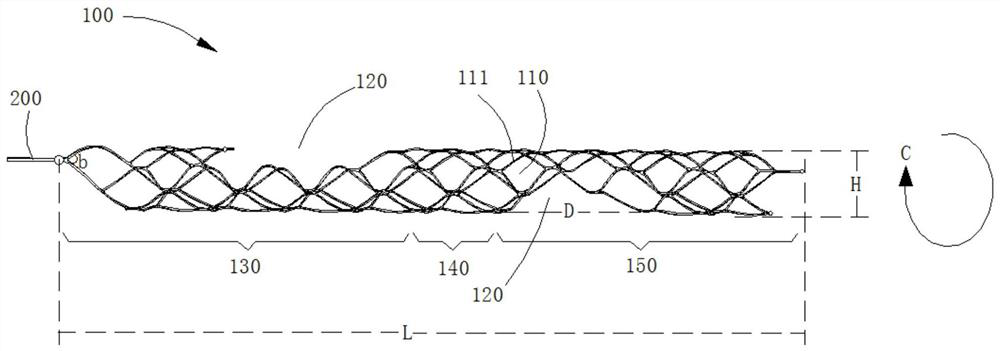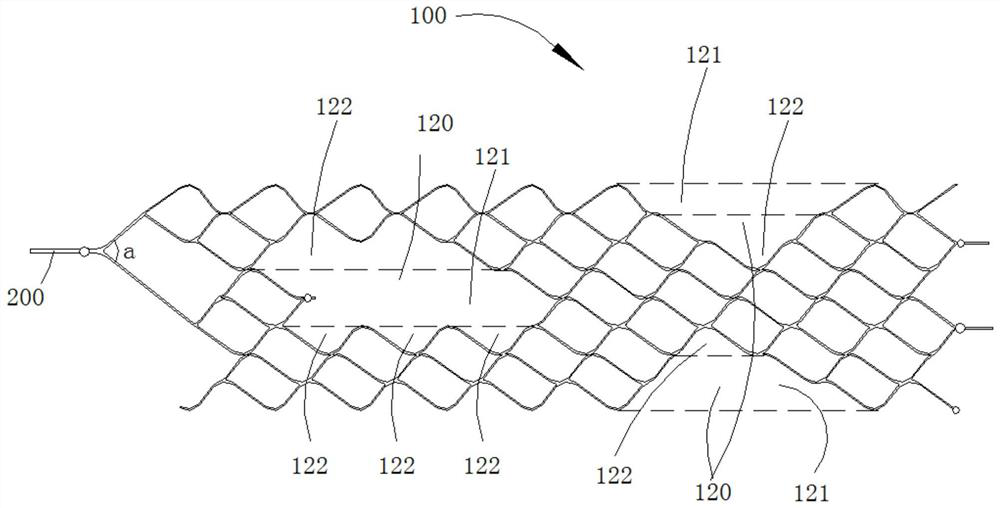Thrombectomy
A thrombectomy and access technology, applied in the field of thrombectomy, can solve problems such as inability to remove hard thrombus well, and achieve the effects of reducing blind spots for thrombectomy, improving thrombectomy efficiency, and increasing coverage.
- Summary
- Abstract
- Description
- Claims
- Application Information
AI Technical Summary
Problems solved by technology
Method used
Image
Examples
Embodiment 1
[0034] Embodiment 1 proposes a thrombus retriever for removing thrombus from a blood vessel of a human or animal body, which can not only effectively remove hard thrombus, but also remove soft thrombus well. Please refer to figure 1 The thrombus retriever 100 includes a hollow mesh-shaped main body formed by connecting several grids 110, so the thrombus retriever 100 has a cavity, and the proximal end of the thrombus retriever 100 (that is, the end connected with the push-pull guide wire 200) and the distal end are both open, and two inlets 120 are arranged at intervals on the outer wall of the mesh tube, and each inlet 120 is surrounded by a plurality of grids 110 to form, so the mesh tube part provided with the inlet 120 has sufficient radial support force, and The pressure generated when in contact with the inner wall of the blood vessel is small, and the damage caused to the inner wall is also small. All the inlets 120 are connected with the cavity of the thrombus remover ...
Embodiment 2
[0050] The same parts of the thrombus remover 700 in Embodiment 2 and the thrombus remover 100 in Embodiment 1 will not be repeated here. The main difference is that, please refer to Figure 12 and Figure 13 , the outer wall of the thrombus retriever 700 in Embodiment 2 is provided with a plurality of inlets 720, and these inlets 720 are distributed in a spiral shape on the outer wall of the thrombus retriever 700, that is, the central points of all the inlets 720 are arranged along the Two adjacent points on the outer wall of the 700 are connected in turn to form a helix, which reduces the blind area of thrombus retrieval, increases the probability of successfully capturing thrombus by releasing the thrombus retriever 700 once, shortens the operation time, and reduces the patient's pain. Please refer to Figure 13 The planar structural view of the thrombus retriever 700 after deployment shown in , among the multiple inlets 720 provided on the thrombus retriever 700 , two ...
Embodiment 3
[0053] The parts of the thrombus remover 800 in Embodiment 3 that are the same as the thrombus remover 100 in Embodiment 1 will not be repeated here. The main difference is that please refer to Figure 14 , the middle section 840 of the thrombus remover 800 in Embodiment 3 is a linear structure respectively connecting the distal end of the proximal section 830 and the proximal end of the distal section 850, and the linear structure is preferably formed by winding a plurality of braided wires , For example, a metal wire with a relatively large atomic mass (gold, thallium, tantalum, etc.) is wound spirally in the axial direction, and it also has a developing effect.
[0054] The thrombus retriever 800 with the middle section 840 of the linear structure can make the proximal end section 830 and the distal end section 850 of the thrombus retriever 800 swing at any angle, thereby adapting to the part of the tortuous blood vessel 500 and avoiding the thrombus retriever 800. Injury t...
PUM
 Login to View More
Login to View More Abstract
Description
Claims
Application Information
 Login to View More
Login to View More - R&D
- Intellectual Property
- Life Sciences
- Materials
- Tech Scout
- Unparalleled Data Quality
- Higher Quality Content
- 60% Fewer Hallucinations
Browse by: Latest US Patents, China's latest patents, Technical Efficacy Thesaurus, Application Domain, Technology Topic, Popular Technical Reports.
© 2025 PatSnap. All rights reserved.Legal|Privacy policy|Modern Slavery Act Transparency Statement|Sitemap|About US| Contact US: help@patsnap.com



